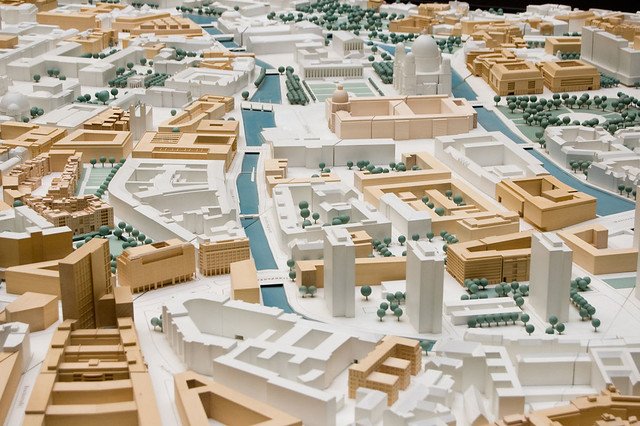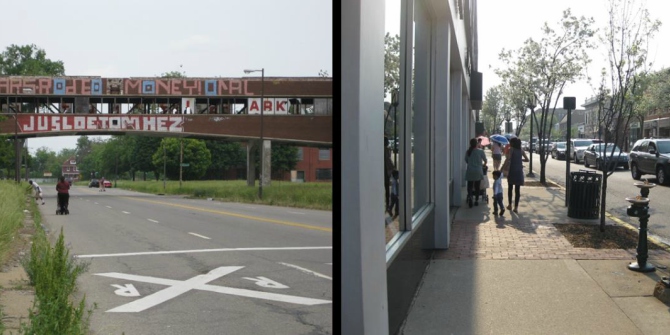 In The New Science of Cities, Michael Batty suggests that to understand cities we must view them not simply as places in space but as systems of networks and flows. Drawing on the complexity sciences, social physics, urban economics, transportation theory, regional science, and urban geography, and building on his own previous work, Batty seeks to introduce theories and methods that reveal the deep structure of how cities function. Andrew Karvonen is impressed and convinced.
In The New Science of Cities, Michael Batty suggests that to understand cities we must view them not simply as places in space but as systems of networks and flows. Drawing on the complexity sciences, social physics, urban economics, transportation theory, regional science, and urban geography, and building on his own previous work, Batty seeks to introduce theories and methods that reveal the deep structure of how cities function. Andrew Karvonen is impressed and convinced.
 The New Science of Cities. Michael Batty. The MIT Press. November 2013.
The New Science of Cities. Michael Batty. The MIT Press. November 2013.
How can mathematical models help us understand contemporary cities? Is it possible to develop a ‘science’ of cities that involves laws and principles to describe and predict how urban change occurs over time and through space? Michael Batty’s book, The New Science of Cities, provides a comprehensive overview of how mathematical models have been developed and applied over the last century to analyse cities. Batty builds upon this overview by incorporating the latest ideas from complexity theory, systems theory, and computer modelling to visualise patterns of urban development. His overarching message is that modelling can provide a useful perspective on urban change and can help inform decision making to realise improved futures.
This book is the latest in a long line of influential work by Batty, notably Fractal Cities: A Geometry of Form and Function (Academic Press, 1994) and Cities and Complexity: Understanding Cities with Cellular Automata, Agent-Based Models and Fractals (The MIT Press, 2005). Batty interprets cities as ‘sets of actions, interactions, and transactions’ (p. 115), a perspective that resonates with the current geographical discourse on relational and topological space. Moreover, the book provides new insights on how design and decision-making processes can be supplemented and enhanced by mathematical modelling and simulation tools. Batty writes that ‘when we step back and consider how cities function and how they might be made more liveable through their planning, we inevitably abstract by peeling back layer after layer of complexity until we alight upon what we might consider fundamental ideas and techniques that compose the foundations of our understanding’ (p. 7).
Modelling, visualisation, and simulation of urban complexity is at the heart of this book. Over three sections and 14 chapters, Batty provides readers with a comprehensive exposition of the building blocks of complexity and network theory – flows, relations, connectivity, networks, hierarchies, spatial syntax, distance, fractals, and so on. He demonstrates the relevance of these abstract ideas by making connections to the major figures of twentieth century urban theory – notably Geddes, Mumford, McHarg, Lynch, Jacobs, and Alexander. Additionally, he introduces the latest insights on network analysis from sociology, political science, and physics to demonstrate the wide range of commonalities between these seemingly disparate disciplines.
The most intriguing chapters in the book are in Part III (The Science of Design) where Batty creates a bridge between the positivist, quantitative modelling approaches from the early to mid-twentieth century with the qualitative, participatory perspectives of planning theorists such as Friedmann, Forester, Healey and others since the 1970s. Complexity theory, like participatory planning, rejects the top-down, comprehensive, and structural approaches of traditional planning practice. Instead, there is a focus on bottom-up, organically structured activities that shape and influence urban systems. Complexity theory also rejects steady state assumptions about cities in place of a non-equilibrium perspective. This highlights the importance of abrupt change and unanticipated consequences, echoing current work on disruptive events caused by social unrest, political and economic instability, and climate change.

It is these insights on bottom-up, organic and unpredictable change that make Batty’s ‘new science of cities’ a refreshing and productive reinterpretation of the positivist modelling approaches of the past. Batty’s science continues to be based in mathematics and probability but it is incremental, uncertain, and modest rather than comprehensive and predictive. And with respect to the planning and design of cities, it suggests that small changes rather than comprehensive masterplans are more effective in steering urban development processes towards more desirable futures conditions (whether they are labelled as liveable, sustainable, or resilient).
Ultimately, this new mode of city science has implications for how models and visualisations are interpreted and applied. Reflecting on the methods and procedures presented in the book, Batty writes, ‘These are tools that are useful for thinking about problems of planning and location, not for generating answers or solutions in the conventional sense of the words’ (p. 336). In essence, the new science of the city uses quantitative modelling approaches to inform and support normative activities aimed at improving the urban environment.
The most obvious audience for this book includes the relatively small number of urban theorists and practitioners who build and apply mathematical and statistical models to analyse cities. However, those of us with only a distant memory of mathematical symbols and basic calculus will benefit from the broader implications of this work. Batty makes a convincing argument that mathematical modelling should not be used as a tool for prediction but as a synthetic lens through which to interpret and visualise urban change. Undoubtedly, the new digital and geospatial analysis protocols that Batty summarises in this work will be essential for processing and analysing the growing volumes of data that are being collected about cities. The ultimate aim is to reveal patterns and trends that would otherwise be invisible to decision makers. While these emerging mathematical modelling and visualisation techniques are not the only way or the best way to study cities, they provide another perspective to inform contemporary ideas on urban design and policy.
Please read our comments policy before commenting.
Note: This article gives the views of the authors, and not the position of USApp– American Politics and Policy, nor of the London School of Economics.
Shortened URL for this post: http://bit.ly/1lIViRW
—————————————–
 Andrew Karvonen – Architecture Research Centre
Andrew Karvonen – Architecture Research Centre
Andrew Karvonen is a Lecturer in Architecture and Urbanism in the Manchester Architecture Research Centre (MARC) at the University of Manchester and a co-director of cities@manchester. Read more reviews by Andrew.






